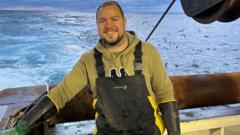As Donald Trump revisits the notion of acquiring Greenland, citing national security as the driver, economic activity in the Arctic appears to be stalling. Sondre Alnes-Bonesmo, a Norwegian fisherman, navigates the unforgiving Arctic Ocean during the dim, frigid winter months while pondering whether he arrived in the region too late for economic opportunities.
The relentless darkness and plummeting temperatures are just part of the fishing tour experience aboard the factory trawler Granit, which operates ceaselessly in Arctic waters. Alnes-Bonesmo, participating in the so-called Arctic "cold rush" that emerged around 2008, sees the potential benefits of climate change as ice melts and shipping routes open, but questions linger over the longer-term viability of economic ventures in this extreme environment.
Recent global tensions, particularly following Russia's 2022 invasion of Ukraine, brought much of the anticipated Arctic development to a halt, as relations between Russia and the West soured. Morten Mejlaender-Larsen of DNV, a firm specializing in maritime standards, highlights how plans for regional rescue centers and shipping infrastructure have stalled. Shipping traffic in the Northeast Passage, once a point of optimistic growth, sees only a few Chinese vessels daring to traverse these waters now.
Norway, too, has curtailed its ambitions in the Arctic, making waves in environmental circles, while mining efforts in deep-sea resources have been suspended, pleasing various environmental advocates. The Norwegian government recently halted licensing for deep-sea mining between Svalbard and Jan Mayen. This shift in policy seems to reflect growing awareness of the environmental stakes tied to industrial operations in the fragile Arctic.
Experts suggest that the prognosis for Arctic shipping was overstated. Helene Tofte from the Norwegian Shipowners Association denotes how the Arctic's daunting conditions make operational success uncertain, necessitating substantial investments in new technology and infrastructure that remain commercially unattractive. As Prof. Arild Moe of the Fridtjof Nansen Institute notes, the optimism surrounding oil and gas exploration may have been based on flawed assessments that conflated potential resources with actual reserves.
Meanwhile, Trump's fixation on Greenland has prompted swift responses from both Greenlandic and Danish authorities, reaffirming that the territory is not for sale. Experts like Prof. Moe highlight that Trump's interest pivots around both security and economic prospects related to its mineral wealth. In the U.S., Trump's administration may also ramp up oil and gas exploration in Alaska's Arctic National Wildlife Refuge, a politically contentious move.
As Alnes-Bonesmo contemplates the prospect of returning to the depths of the Arctic Ocean, he feels a mixture of fear and reverence for its untamed beauty despite the shrinking fishing quotas faced in light of conservation efforts.
The relentless darkness and plummeting temperatures are just part of the fishing tour experience aboard the factory trawler Granit, which operates ceaselessly in Arctic waters. Alnes-Bonesmo, participating in the so-called Arctic "cold rush" that emerged around 2008, sees the potential benefits of climate change as ice melts and shipping routes open, but questions linger over the longer-term viability of economic ventures in this extreme environment.
Recent global tensions, particularly following Russia's 2022 invasion of Ukraine, brought much of the anticipated Arctic development to a halt, as relations between Russia and the West soured. Morten Mejlaender-Larsen of DNV, a firm specializing in maritime standards, highlights how plans for regional rescue centers and shipping infrastructure have stalled. Shipping traffic in the Northeast Passage, once a point of optimistic growth, sees only a few Chinese vessels daring to traverse these waters now.
Norway, too, has curtailed its ambitions in the Arctic, making waves in environmental circles, while mining efforts in deep-sea resources have been suspended, pleasing various environmental advocates. The Norwegian government recently halted licensing for deep-sea mining between Svalbard and Jan Mayen. This shift in policy seems to reflect growing awareness of the environmental stakes tied to industrial operations in the fragile Arctic.
Experts suggest that the prognosis for Arctic shipping was overstated. Helene Tofte from the Norwegian Shipowners Association denotes how the Arctic's daunting conditions make operational success uncertain, necessitating substantial investments in new technology and infrastructure that remain commercially unattractive. As Prof. Arild Moe of the Fridtjof Nansen Institute notes, the optimism surrounding oil and gas exploration may have been based on flawed assessments that conflated potential resources with actual reserves.
Meanwhile, Trump's fixation on Greenland has prompted swift responses from both Greenlandic and Danish authorities, reaffirming that the territory is not for sale. Experts like Prof. Moe highlight that Trump's interest pivots around both security and economic prospects related to its mineral wealth. In the U.S., Trump's administration may also ramp up oil and gas exploration in Alaska's Arctic National Wildlife Refuge, a politically contentious move.
As Alnes-Bonesmo contemplates the prospect of returning to the depths of the Arctic Ocean, he feels a mixture of fear and reverence for its untamed beauty despite the shrinking fishing quotas faced in light of conservation efforts.


















